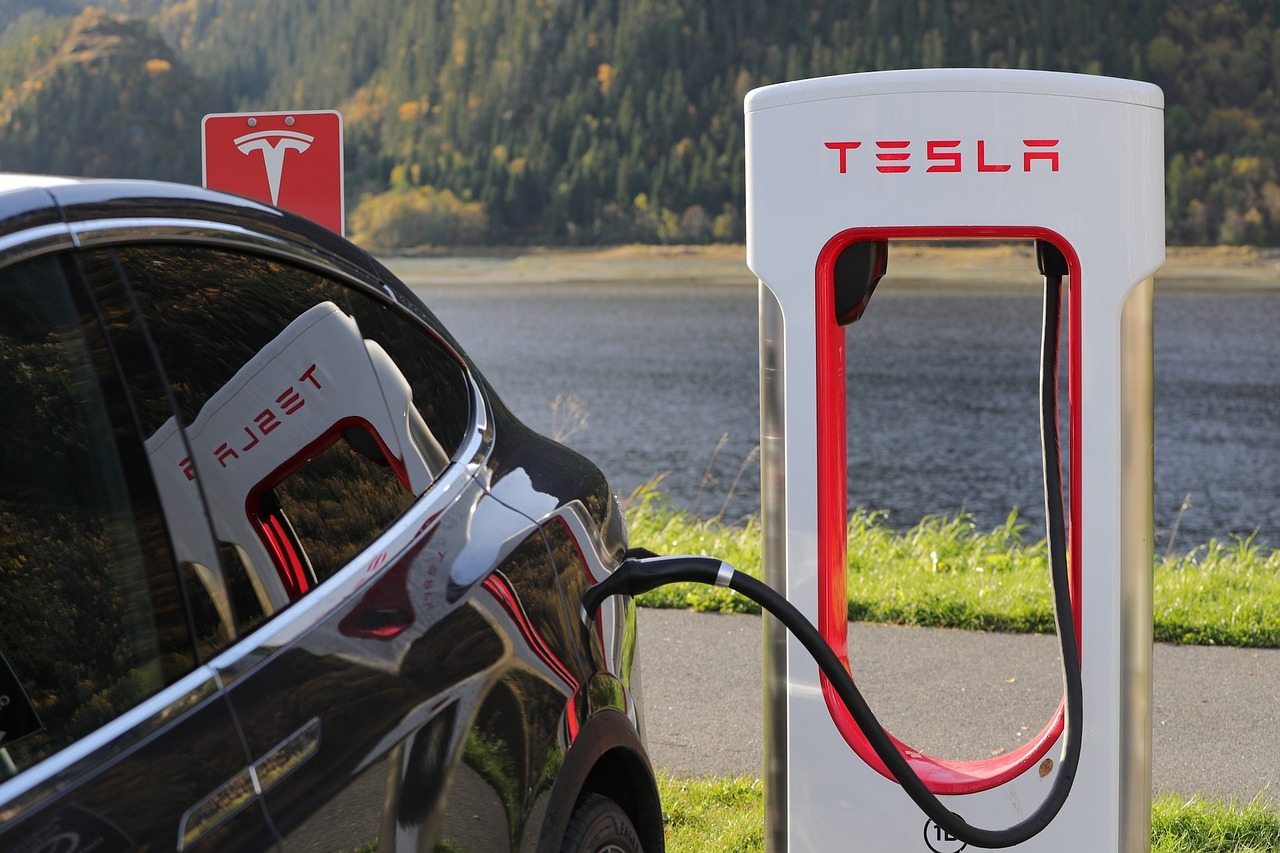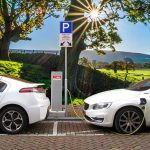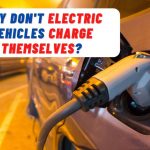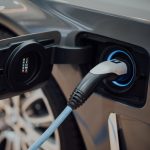Last Updated on December 1, 2022 by

Electric vehicles are becoming more and more popular every day. With their decreased environmental impact, many people are looking to switch to electric cars or trucks.
But what happens if an electric vehicle needs to cross a body of water? Can it make it through?
In this blog post, we’ll explore the feasibility of driving an electric vehicle through water and look at some of the challenges you may face.
Can electric cars get wet?
It’s a common misconception that electric cars can’t get wet. In fact, most electric cars are designed to be driven in all weather conditions, including rain and snow.
However, it’s important to take care when driving an electric car in wet weather.
- Firstly, it’s important to make sure that the charging port is completely dry before plugging in the charger. If the port gets wet, it could short-circuit and cause damage to the car.
- Secondly, it’s best to avoid puddles and standing water, as this could cause the electrical system to overheat.
- Finally, it’s a good idea to have your car serviced regularly to ensure that the brakes and tires are in good condition.
- With a little care, you can enjoy driving your electric car in all kinds of weather.
Can a Tesla drive through water?
The Tesla Model S is an all-electric car with several unique features that set it apart from other vehicles on the market.
One feature that has attracted a lot of attention is its ability to drive through water. However, this does not mean that the Model S is completely waterproof.
The car’s electrical system is designed to protect against short circuits, but it is not designed to withstand being submerged for an extended period of time.
As a result, driving through deep water is not recommended and could damage the car’s battery, motors, and other components.
What happens if you drive an electric car into the water?
If you drive an electric car into the water, it’s important to act quickly to avoid serious damage to the vehicle.
- First, turn off the power to the car by flipping the switch on the battery. This will prevent any further electrical current from flowing through the car and causing damage.
- Next, attempt to get the car out of the water as soon as possible. If it’s too late to avoid damage, call a tow truck or tow the car out yourself.
- Once the car is out of the water, dry it off as much as possible and open all the doors and windows to help ventilate the interior.
- Then, take it to a mechanic or dealership to have it inspected for water damage.
Can electric trucks go through water?
Electric trucks are powered by batteries, which means they don’t produce emissions. This makes them more environmentally friendly than traditional diesel trucks. Electric trucks also tend to be quieter, which is beneficial in urban areas.
However, one potential drawback of electric trucks is that they may not be able to go through water. This is because the battery could short-circuit if it got wet.
As a result, electric trucks may not be suitable for all applications. For instance, they would not be ideal for use in a construction site where there is a lot of mud or water.
Myth Busters drive an electric car through a flood?
When the Mythbusters team decided to see if an electric car could drive through a flood, they knew they were in for a challenge.
After all, water and electricity don’t mix. But with the help of some expert advice, they were able to safely navigate their way through the flood.

The results were impressive, to say the least. Not only did the car make it through the water, but it barely missed a beat. The team was even able to continue driving after the water had receded.
This experiment proved that electric cars are tougher than they look and can stand up to even the most challenging conditions.
How deep in water can an electric car go?
The ability of an electric car to operate in water depends on a variety of factors, including the depth of the water, the type of battery, and the design of the car.
Most electric cars are designed for use in shallow water, such as fordable streams or flooded roads.
The battery and electrical components are sealed to prevent water damage, and the wheels are usually raised off the ground to minimize contact with the water. However, electric cars can be driven in deeper water if necessary.
Can you drive a hybrid car through water?
The debate over whether or not hybrid cars can be driven through water has been a hot topic in recent years.
While some manufacturers claim that their hybrids are designed to resist water damage, others caution against driving through floodwaters or deep puddles.
So, what’s the truth? Can you drive a hybrid car through water?
The answer, unfortunately, is that it depends. Some hybrids, such as the Toyota Prius, are equipped with special features that help to protect the engine from water damage. However, other hybrids are not as resistant to flooding.
If you’re unsure about whether or not your hybrid can handle driving through water, it’s best to err on the side of caution and avoid driving through any large bodies of water.
What happens if an electric car crashes into the water?
Electric cars are becoming increasingly popular as consumers look for more environmentally-friendly transportation options. However, one potential hazard of electric cars is that they can pose a danger if they crash into the water.
Unlike gasoline-powered cars, electric cars rely on batteries to operate, and those batteries can be damaged if they come into contact with water.
As a result, an electric car that crashes into a lake or river could leak harmful chemicals into the water, harming plant and animal life.
Electric car wading depth
It’s important to know the wading depth of your car when driving in flood conditions. The last thing you want is to be stranded in the middle of a road with water rushing all around you.
Electric cars have a lower wading depth than petrol or diesel cars. So it’s important to be aware of this when making your decision on which car to buy.
The wading depth of an electric car is the height of the water that the car can safely drive through without being damaged. The wading depth of most electric cars is between 10 and 20 cm.
Can the motor Mythbusters drive an electric car through a flood?
The Mythbusters often take on challenging myths, and one of their most recent myths was whether or not an electric car could drive through a flood.
The team put an electric car through a series of tests, including driving it through a flooded tunnel and submerging it in a tank of water.
The results were conclusive: the electric car performed well in both tests and showed no signs of water damage. This is good news for owners of electric cars, as it means that their vehicles are more resistant to flooding than previously thought.
Can electric cars electrocute you?
Although electric cars are becoming increasingly popular, there is still some concern about their safety.
One worry is that drivers could be electrocuted if they come into contact with the electrical system. However, as long as drivers take some basic precautions, this should not be a problem.
The electric current in an electric car is stored in high-voltage batteries, which are located under the floor or in the trunk. These batteries are not exposed, so there is no risk of coming into direct contact with them.
Can an electric car go through a carwash?
Many people are curious about whether electric cars can go through a carwash. The answer is that it depends on the type of carwash.
Traditional, tunnel-style carwashes typically use a conveyor belt to move the car through a series of cleaning stations.
These carwashes are not well suited for electric cars, as the conveyor belt can damage the battery or cause other problems. However, there are a number of newer, touchless carwashes that use high-pressure jets of water to clean the car.
Ev water
Water is one of the most essential elements for life, and yet it is something that we often take for granted. Every day, we use water for drinking, cooking, cleaning, and bathing. But where does this water come from?
For many of us, the answer is simple: from the tap. We turn on the faucet and out comes water, seemingly without effort on our part.
However, what we often don’t realize is that this water has actually been through a long and complex journey before it reaches our homes.
In order to understand how our water gets to us, we first need to know a little bit about the water cycle. The water cycle is the process by which water circulates through the Earth’s atmosphere, seas, and land.
FAQ relating to Can electric vehicles drive through water?
How many gallons of water does it take to put out a Tesla fire?
According to firefighters, it can take up to 1,000 gallons of water to put out a Tesla fire. This is because the lithium-ion batteries used in Tesla cars produce highly flammable gas when they catch fire.
Why are electric car fires so hard to put out?
Unlike gasoline-powered cars, electric cars rely on large batteries to store energy. These batteries are filled with highly flammable chemicals, and if they are damaged or overloaded, they can catch fire.
As a result, electric car fires are a major safety concern for both drivers and firefighters.
How do firefighters put out electric car fires?
It’s a scene that has played out in many Hollywood blockbusters: a car bursts into flames, and a team of firefighters rushes to the rescue. But what happens when the car that’s on fire is an electric vehicle? How do firefighters put out an electric car fire?
The first thing to understand is that electric car fires are very rare. In fact, there are fewer than 300 reported cases of electric car fires each year in the United States. That’s a tiny fraction of the more than 1.3 million gasoline-powered car fires that occur annually.
How do firefighters put out Tesla fires?
Car fires are no laughing matter. Not only are they incredibly dangerous, but they can also be extremely difficult to extinguish. This is especially true for electric cars, like the Tesla Model S.
The high-voltage battery pack used in these vehicles can continue to emit electricity long after the fire has been extinguished, posing a serious risk to firefighters.
As a result, traditional firefighting techniques are often ineffective against Tesla fires. Instead, firefighters must rely on a combination of water and dry chemical extinguishers to cool the battery pack and prevent it from re-igniting.
Key Takeaway
- While electric vehicles have many benefits over traditional gas-powered cars, one of the drawbacks has been their inability to travel in water.
- However, a new type of electric vehicle that can drive through water may be on the horizon, which would make this mode of transportation even more environmentally friendly and convenient.
Are you excited about the possibility of an electric car that can also drive through water? Let us know in the comments!
- Why Electric Vehicles Are Not Popular - January 29, 2023
- How Long Do Tesla Batteries Last Per Day? Battery Facts - January 25, 2023
- Do Electric Vehicles Have Air Conditioning? - December 21, 2022










